Lesson 3
| Site: | MoodleHUB.ca 🍁 |
| Course: | Math 30-1 SS |
| Book: | Lesson 3 |
| Printed by: | Guest user |
| Date: | Tuesday, 9 December 2025, 10:35 PM |
Description
Created by IMSreader
1. Lesson 3
Module 8: Permutations, Combinations, and the Binomial Theorem
Lesson 3: Combinations
Focus

iStockphoto/Thinkstock
In his book The Codebreakers: The Story of Secret Writing, David Kahn tells the story of how a New York City detective broke up a betting ring. The detective observed the bookie taking bets and writing them down. However, when the detective made the arrest, much to his surprise, the list did not consist of names and betting amounts. Rather, the list contained a series of musical notes.
Convinced that the notes must be a code, the detective took the list for cryptanalysis. Sure enough, when played, the notes did not result in beautiful music. The notes were a code! When broken, each code provided the identity of the person and the amount of the bet. The detective solved his case.
There have been other cases of music notes being used to deliver hidden messages. The code might be in the lyrics or within the notes themselves.
The piano is one of the most common musical instruments in the world. A typical keyboard has 88 keys with a repetitive naming sequence as shown in the following partial keyboard diagram. Keys with the same name, such as two A notes, sound similar, but one note is higher than the other.
A chord can be produced on a piano when more than one key is pressed at the same time. How can you determine the number of different chords a piano can produce? What if you want chords using only the white keys? Suppose the pianist’s fingers could only span eight white keys. How can you determine how many one-handed chords can be produced?
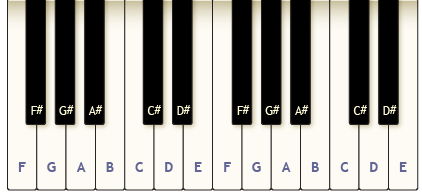
In Lesson 2 you examined permutations—the number of ways objects can be arranged when order is important. On the piano, the order in which a chord is written or played does not change the sound. ACE is the same as CAE since all keys are pressed at the same time in a chord.
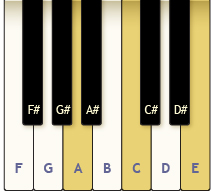
In this lesson you will explore a method of determining the number of ways to select objects if the order is not important.
Lesson Outcomes
At the end of this lesson you will be able to determine the number of combinations of elements given certain criteria.
Lesson Questions
In this lesson you will investigate the following questions:
- What are the similarities and differences between permutation and combination problems?
- How are problems involving combinations solved?
- How do you solve equations involving combinations?
Assessment
Your assessment may be based on a combination of the following tasks:
- completion of the Lesson 3 Assignment (Download the Lesson 3 Assignment and save it in your course folder now.)
- course folder submissions from Try This and Share activities
- additions to Glossary Terms and Formula Sheet
- work under Project Connection
1.1. Discover
Module 8: Permutations, Combinations, and the Binomial Theorem
Discover
Try This 1
Suppose you are planning to open an ice cream stand and have 4 kinds of ice cream: chocolate, vanilla, strawberry, and tiger. You plan to serve 2 different scoops at a time. Use Two Scoops to determine how many two-flavour cones can be made.

- If you wanted to advertise the number of different two-flavour cones available, would you calculate the number available by using 4P2 = 12? Explain.
- If you added another flavour, blueberry, how many different cones could you produce?
![]() Save your responses in your course folder.
Save your responses in your course folder.
Share 1
With a partner or group, discuss the following questions based on what you discovered in Try This 1.
- In Two Scoops, what do you suppose the 4 and the 2 represent in 4C2 if the C stands for combination?
- Think of another scenario where you might use combinations instead of permutations.
![]() If required, save a record of your discussion in your course folder.
If required, save a record of your discussion in your course folder.
1.2. Explore
Module 8: Permutations, Combinations, and the Binomial Theorem
Explore
In Try This 1 you looked at permutations and combinations of ice cream cones. The number of combinations is the number of ways you can select items from a group when order does not matter. In Two Scoops, a chocolate-strawberry cone is the same as a strawberry-chocolate cone.
You may have noticed in Try This 1 that the notation for combinations is similar to that of permutations.
| Notation | Order | Ice Cream Cone Possibilities | |
| Combination | nCr | Order doesn’t matter. | 4C2 = 6 |
| Permutation | nPr | Order matters. | 4P2 = 12 |
In Try This 1, nCr represents taking r objects (two flavours) from a group of n objects (four possible flavours), when order does not matter. In nPr, the restriction on r is r ≤ n.
This restriction on r is also true for nCr because you can’t choose more objects than are available.
In Try This 2 you will explore combinations and compare them to permutations.
Try This 2
Step 1: Open “Permutations and Combinations.”
In “Permutations and Combinations” you see the number of ways you can take items from a box. You are also allowed to decide whether or not to pay attention to the order in which you take the items from the box.
Step 2: Set “Number of tiles in box” to 3. Set “Number of draws from box” to 2, and then select “Yes” to indicate the order is important, as shown in the diagram. This setting corresponds to the first line of the following table. Hit “Simulate.” Switch between the tabs at the top for different representations of the information.
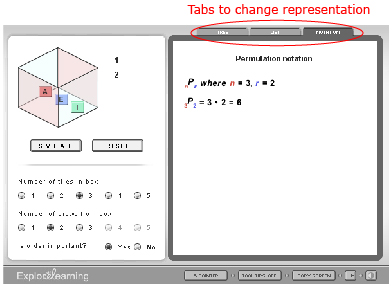
Screenshot reprinted with permission of ExploreLearning
Complete a table like the one shown by changing the tiles, draws, and order of importance.
| Tiles | Draws | Is order important? | Number of Possibilities | Sketch of Tree Diagram | Notation | Permutation or Combination |
| 3 | 2 | yes | 6 | 3P2 | permutation | |
| 3 | 2 | no | ||||
| 5 | 2 | yes | Do not draw. | |||
| 5 | 2 | no | Do not draw. | |||
| 4 | 3 | no | Do not draw. | |||
| 4 | 4 | no | Do not draw. | |||
| 5 | 5 | no | Do not draw. |
![]() Save your responses in your course folder.
Save your responses in your course folder.
Share 2
With a partner or group, discuss the following questions based on what you discovered in Try This 2.
-
How did the tree diagram change when you switched from order being important to being not important?
- Why are there fewer combinations of a specified number of items as compared to the number of permutations?
- “Permutations and Combinations” shows that the permutation and combination formulas are related by
 Explain why dividing the number of permutations by r! gives the number of combinations.
Explain why dividing the number of permutations by r! gives the number of combinations. - Think of a real-life example where you would be interested in the number of combinations rather than the number of permutations.
1.3. Explore 2
Module 8: Permutations, Combinations, and the Binomial Theorem
In “Permutations and Combinations” you may have noticed that you could represent the number of combinations 5C3 as ![]() The number of combinations, nCr, is equal to the number of permutations, nPr, divided by the number of ways the elements could be arranged, r!
The number of combinations, nCr, is equal to the number of permutations, nPr, divided by the number of ways the elements could be arranged, r!
In Two Scoops, you saw 2!, or 2, duplicates for each cone, so there were twice as many permutations as combinations.
Your calculator likely has a nCr button that will calculate the number of combinations for you. Note that some textbooks use an alternate notation for combinations ![]() where
where ![]()
In Two Scoops you could have written ![]() and known that this meant 4C2. You evaluated this equation and got 6.
and known that this meant 4C2. You evaluated this equation and got 6.
The combination function on your calculator will likely be found in the same menu as the permutation function. Make sure you can evaluate combinations and permutations using your calculator. Check with your teacher if you have trouble finding these functions.
Self-Check 1

Brand X Pictures/Thinkstock
A Grade 12 class of 120 students is forming a graduation committee.
1.4. Explore 3
Module 8: Permutations, Combinations, and the Binomial Theorem
So far you have seen that ![]() can be used to determine the number of combinations. It is also possible to rewrite this formula without the permutation component.
can be used to determine the number of combinations. It is also possible to rewrite this formula without the permutation component.

So, the combination formula is as follows:

Read part a. of “Example 1” on pages 530 and 531 of the textbook to see how the combination formula is used when making selections.

Brand X Pictures/Thinkstock
Self-Check 2
In how many ways can a coach choose his or her starting lineup of 5 basketball players if there are 15 players to choose from? Answer

iStockphoto/Thinkstock
Have you ever had a combination lock given to you for a locker at school? Is this an appropriate name for this item? The word combination implies that order is not important. However, you know that if the numbers are not dialed in the right order with the correct rotation in between, the lock will not open. Perhaps these kinds of locks should be called permutation locks.
1.5. Explore 4
Module 8: Permutations, Combinations, and the Binomial Theorem
As with permutations, there are often extra conditions placed on the choices to be made. If, in Self-Check 2, the coach had to make choices based on positions, the number of combinations would change. Consider the scenario in Try This 3.
Try This 3

Ron Chapple Studios/Thinkstock
A hockey coach wishes to choose a first line. The coach has to choose 1 of 5 centres, 1 of 7 right wingers, 1 of 6 left wingers, and 2 of 10 defence players. In how many ways can the coach choose the first line?
Use a table similar to the following table to help solve the problem.
| Position | Centre | Right Wing | Left Wing | Defence | |
| Number of Players to Choose From | 5 | 7 | 6 | 10 | |
| Number on Ice at One Time | 1 | 1 | 1 | 2 | |
| Combination Notation | |||||
| Number of Ways to Fill Each Position | |||||
| Total Number of Ways | total = ? |
||||
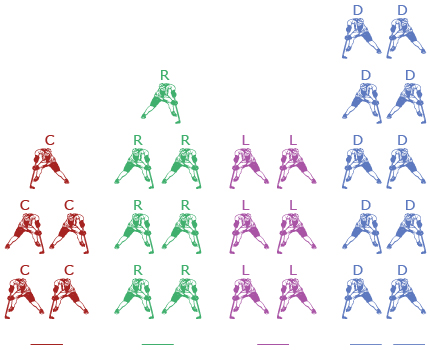
Hemera/Thinkstock
![]() Save your responses in your course folder.
Save your responses in your course folder.
Share 3
With a partner or group, discuss the following questions based on your answer to Try This 3.
- Compare the ways your group determined how the starting line could be formed.
- Of the methods you saw, describe the one that seems most efficient.
![]() If required, save a record of your discussion in your course folder.
If required, save a record of your discussion in your course folder.
total = 5 × 7 × 6 × 45 = 9450
1.6. Explore 5
Module 8: Permutations, Combinations, and the Binomial Theorem
In Try This 3 the coach must choose a centre and a right wing and a left wing and two defence. By using the fundamental counting principle, you multiply the number of choices for each position to determine the total number of ways to make these choices.
- centre: 5C1
- right wing: 7C1
- left wing: 6C1
- two defense: 10C2
The total number of ways the coach can choose the first line is 5 × 7 × 6 × 45 = 9450 ways.
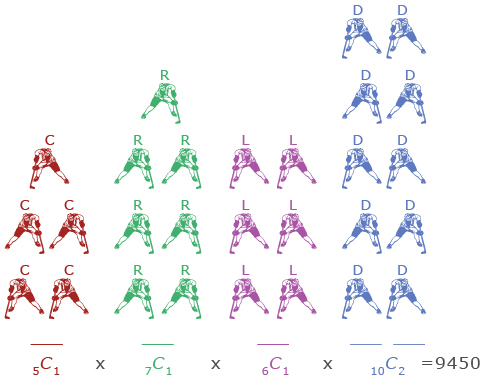
Hemera/Thinkstock
If you want to see another example of a combination question with extra conditions, read through the rest of “Example 1” on pages 530 and 531 of the textbook.
Self-Check 3
- The student activities committee consists of 5 students from Grade 10, 5 students from Grade 11, 8 students from Grade 12, and 2 teachers. How many dance subcommittees can be formed if there must be 2 students from each grade and only 1 teacher? Answer
- Complete “Your Turn” on the bottom of page 531 of the textbook. Answer
1.7. Explore 6
Module 8: Permutations, Combinations, and the Binomial Theorem
You used cases in some of the permutation calculations in Lesson 2. You would add the number of permutations in each case to determine the total. There are also some combination questions that require the use of cases.

AbleStock.com/Thinkstock
Pianists can create different chords by pressing several keys down at the same time on a piano.
Think about how many chords are possible in each of the following situations.
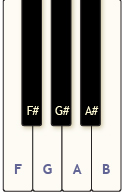
- Using the keys from the piano as shown, how many different chords—combinations of two or more keys—can be produced using exactly four fingers if each finger only presses one key, black or white, at a time?
- How many chords can be produced using three or four fingers?
- How many chords can be produced using two or three or four fingers?
Watch Piano Chords to see how the number of chords can be calculated for each situation.

1.8. Explore 7
Module 8: Permutations, Combinations, and the Binomial Theorem
In Piano Chords you saw that cases were required because you could use two, three, or four fingers. The number of combinations for each case was then added to determine the total number of combinations.
To see another example of solving combination problems by considering cases, read “Example 2” on page 532 of the textbook. As you read, pay special attention to what the phrase “at least” means when determining the number of combinations.
Self-Check 4
Complete “Your Turn” at the bottom of page 532 of the textbook. Answer
In Self-Check 4 you realized that when there are different scenarios, you have to add the combinations together to get the total number of combinations for all possible scenarios.
Try This 4
One of the most important pieces of identification you can have is your passport. Every country has different rules on how to obtain a passport. Consider the Australian Passport Offices’ “Documents that confirm your Australian citizenship and identity.” The document refers to lodgement. Lodgement refers to where you will be residing.
-
Assuming that you have each of the documents from categories A, B, and C and that you have two official documents that include your photograph, in how many ways can you supply the documentation required for combinations 1, 2, and 3?
-
Are there more combinations for lodgement in Australia or for lodgement overseas?
-
Why do you think the Australian Passport Office requires more documents from Category C than from Category A or Category B?
1.9. Explore 8
Module 8: Permutations, Combinations, and the Binomial Theorem
Self-Check 5
Add the formula for combinations to your copy of Formula Sheet:

1.10. Connect
Module 8: Permutations, Combinations, and the Binomial Theorem
Complete the Lesson 3 Assignment that you saved in your course folder at the beginning of the lesson. Show work to support your answers.
![]() Save your responses in your course folder.
Save your responses in your course folder.
Project Connection
Go to Module 8 Project: Creating the Ultimate Password. Complete Activity 3: Memorable Passwords.
![]() Save your responses in your course folder.
Save your responses in your course folder.
1.11. Lesson 3 Summary
Module 8: Permutations, Combinations, and the Binomial Theorem
Lesson 3 Summary
Combinations can be used to solve counting problems where the order is not important. A combination can be represented by nCr or ![]() where n is the size of the group from which the objects are taken and r is the number of objects that are taken at a time. The following formula can be used to calculate a combination where 0 ≤ n ≤ r:
where n is the size of the group from which the objects are taken and r is the number of objects that are taken at a time. The following formula can be used to calculate a combination where 0 ≤ n ≤ r:
![]()
Many problems will require you to calculate multiple combinations and then apply the fundamental counting principle.
